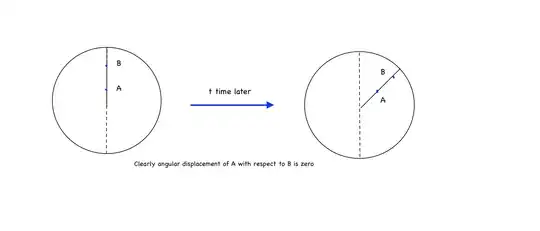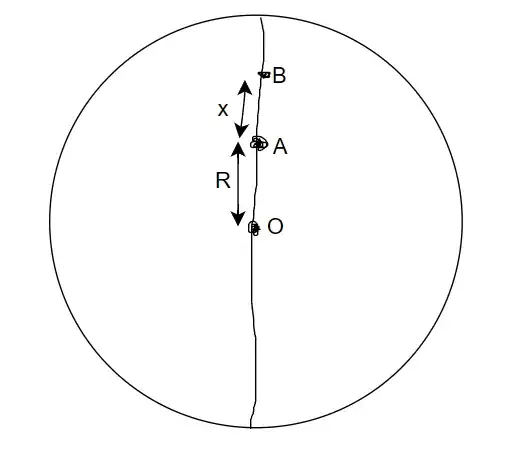Let me explain my doubt with help of an example consider a disc of radius $2R$ rotating with contant angular velocity $\omega$ locate two particles $A$ at a distance $R$ from centre and $B$ at a distance $2R$ from the centre, we know that $\omega_A=\omega$ and $\omega_B=\omega$ ,Also $v_A=R\omega$ and $v_B=2R\omega$ , now $\omega_{B/A}=\dfrac{v_{B/A}}{r_{B/A}}=\omega$ but if I use the definition $\omega=\dfrac{d{\theta}}{dt}$ we get a contradicting result, $\omega_{B/A}=\dfrac{d{\theta}}{dt}=0$ since $\theta$ is the angle between the line joining them which does not change with time. My doubts
- Is $\omega=\dfrac{d{\theta}}{dt}$ always valid , even for rotating frames, If yes how do I derive ralative angular velocity between the two particles only using this definition?
- Am I making any conceptual error?
EDIT 1 : For a rigid body we can say each point turns relative to other point of the rigid body with same angular velocity at a given instant. So $\omega_{B/A}$ is indeed equal to $\omega$.Then why the contradiction occurs?
EDIT 2: https://www.brown.edu/Departments/Engineering/Courses/En4/notes_old/RigidKinematics/rigkin.htm Please check this link and see under 5.1.3 section where they derive equations governing general plane motion , there also they have used $\omega _{B/A}= \omega$ of the rigid body where A and B are any two arbitrary points.
EDIT 3: See that the equation $v_{A}=v_{B}+\omega_{B/A}×r_{A/B}$ where $\omega_{B/A}=\omega$ furthermore if we transform the equation we can se $v_{B}=v_{A}+\omega×r_{B/A}$ hence cocluding my point that $\omega_{B/A}=\omega_{A/B}=\omega$
EDIT 4: you can also see what I am trying to say here https://en.m.wikipedia.org/wiki/Angular_velocity under Rigid Body Consideration , Consistency.
EDIT 5: Here are some more links to support $\omega_{B/A}=\omega$
- Relative angular velocity of point with respect to another point
- Angular velocity about an arbitrary point
"Consider a rigid body rotating with angular velocity $\omega$ . Now, we know that this $\omega$ is an intrinsic property for the rigid body, in the sense that: Each point on the rigid body rotates with $\omega$ relative to any other point on the rigid body."
"An important feature of spin angular momentum is that it is independent of the coordinate system. In this sense it is intrinsic to the body; no change in coordinate system can eliminate spin, whereas orbital angular momentum disappears if the origin is chosen to lie along the line of motion." , Source: An introduction to mechanics Textbook by Daniel Kleppner and Robert J. Kolenkow.

